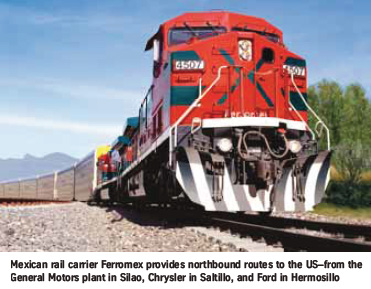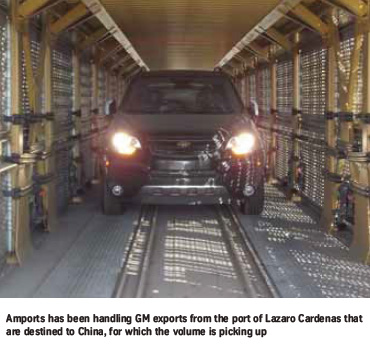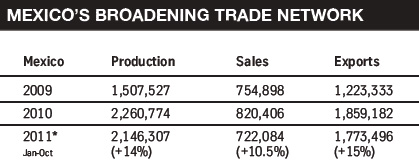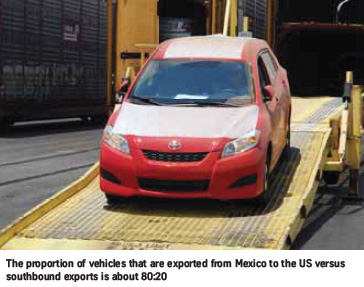Mexico is the fastest growing region for vehicle production in North America. While its benefiting from some recovery to its main market in the US, it is also expanding its links to the south in Latin America, reports Anthony Coia
Mexican automotive production has long been driven by exports to the US, while its domestic market has tended to be more unpredictable. For 2011, recovery in the US market may have been slower than many had hoped, but steady increases–along with similar growth in the domestic Mexican market–have helped keep production strong. Besides the recovery in northbound exports, trade agreements with other markets in South America, Brazil in particular, have also encouraged carmakers to use the country as a base for exports to the south as well as north. On pace to produce 2.5m vehicles in 2011, Mexico’s export demand growth–up 15% in the first ten months of 2011–has led to the development of increased capacity at General Motors’ plant in Silao and Ford’s in Hermosillo. Mazda and Honda are also building new plants, and in October Nissan announced the construction of a second plant in Aguascalientes.
 Northbound network
Northbound network
The main transport mode for finished vehicle traffic between Mexico and the US is rail. From Mexico, Chrysler ships all of its vehicles by rail for the US and Canadian markets, according to BJ Alicandro, manager, vehicle damage prevention and claims. He says that Chrysler’s main objectives are to maximise delivery velocity, reduce empty miles and greenhouse gas emissions and eliminate damage. Ford moves its exports from Mexico to the US and Canada mainly by rail. Bill Mikkelsen, Ford North America vehicle logistics manager, says that the sustainability and flexibility of the Mexican transport network is essential for meeting the growing demand in this region. “Last year, we forecasted a railcar shortage due to increased demand. Our solution was to use ocean carriers to transport our vehicles to the eastern United States,” he says. Union Pacific Railway ships new vehicles northbound from Mexico through four border gateways for final delivery in the US and Canada. Among them, significant volume moves to port locations and localities that serve northern and southern California, Oregon and Washington. Shipments cross the US-Mexico border at Laredo and Eagle Pass, where Union Pacific has built the Clarks Park staging yard to increase capacity and improve the efficiency of interchange operations. Union Pacific offers direct access to Mexico’s six major rail gateways: Calexico, Nogales, El Paso, Eagle Pass, Laredo and Brownsville, from which it connects to Mexico’s 32,000km rail network. Linda Brandt, vice president and general manager of autos at Union Pacific, notes that Eagle Pass and Laredo receive the highest finished vehicle volumes moving northbound from Mexico.
Eagle Pass connects directly to Ferromex and Laredo to Kansas City Southern Mexico (KCSM). “El Paso is typically used for destinations on the US West Coast. Volumes through the Nogales gateway are also growing; Nogales is critical for handling vehicles that are produced in western Mexico,” says Brandt. Mexican rail carrier, Ferromex, provides three primary routes to the US–from the General Motors plant in Silao, Chrysler’s plant in Saltillo, and Ford’s facility in Hermosillo, according to Hector Cuevas, vice president sales, automotive, agricultural, industrial, and intermodal. It also carries Hondas from Guadalajara and Nissans from Aguascalientes. Tom Naso, assistant vice president, autos at Ferromex, points out that the skew is much heavier from Mexico to the US than vice versa. The proportion of exports moving north compared to south is approximately 80:20.
Ocean exports
Demand for rail transport is on the rise. “We are experiencing a strong increase in exports from central Mexico to the US,  sails every two-to-three weeks. “We have also started to push for more standardised handling processes at our ports. For example, our increase in exports highlighted the need to improve the undercoating process; we were doing it differently at different facilities,” says Alicandro. MOL Bulk Shipping offers twice monthly sailings from Mexico to South America. “We have seen higher ports from Mexico to Brazil within the past 18 months. Among e driving factors is the free trade agreement between the countries as well as the upcoming Olympics and World Cup events in Brazil,” says Paul Carlton, president.
sails every two-to-three weeks. “We have also started to push for more standardised handling processes at our ports. For example, our increase in exports highlighted the need to improve the undercoating process; we were doing it differently at different facilities,” says Alicandro. MOL Bulk Shipping offers twice monthly sailings from Mexico to South America. “We have seen higher ports from Mexico to Brazil within the past 18 months. Among e driving factors is the free trade agreement between the countries as well as the upcoming Olympics and World Cup events in Brazil,” says Paul Carlton, president.
Houmlegh Autoliners calls at Veracruz or its Europe–Caribbean/Mexico/ US route twice monthly to discharge European cargo and to load Mexican cargo on the same vessels for discharge in the US and Europe. Steinar Loslashvdal, head of region, Americas, says there has been an increase in ocean volumes that, at least to some extent, has been a result of rail capacity shortages as well as the general growth in vehicle production and export in Mexico. “We believe that this market will remain strong going forward. Our Mexican export volumes to both the US and Europe are mostly limited to one vehicle manufacturer and the service is, as such, stable in terms of cargo base and ports,” says Løvdal. Höegh Autoliners also tranships some Mexican cargo to other destinations such as the Middle East via the US and these volumes have been growing. “Apart from the regular volumes that we receive from our main customer in the Mexico-US trade lane, we have done some spot shipments from Mexico to the US that have been directly related to a lack of rail capacity. Our vessels are, however, often full out of Mexico with our regular volumes and we have not actively been targeting volumes currently carried by rail or short sea services,” he explains. Adds Løvdal: “The main challenge is that since our export service from Mexico is primarily based on cargo for Europe and the European cargo has priority on the vessels, the capacity available from Mexico to the US varies. We work with our largest customer to obtain as accurate volume forecasts as possible in order to enable us to plan volumes against capacity.”
 Vehicle processing connections
Vehicle processing connections
Vehicle processor Amports Mexico operates three primary facilities: the ports of Lazaro Cardenas and Altamira and KCSM’s facility in Toluca, for which it provides accessorisation and preparation for Mazda. German Eichelmann, senior manager, sales and business development, says that more value-adding services are taking place at the ports. “For exports, we opened an undercoating pit at Lazaro Cardenas less than one year ago and at Altamira in September. Since May, we have processed 1,000 truck exports per month for Navistar that are destined for Colombia. These include all kinds of heavy-duty equipment mostly, such as cement trucks,” he says.
Also at Lazaro Cardenas, Amports has been handling GM Cadillac exports to China for one year and the volume is picking up. Its body shop also handles mid-size Hino and Isuzu truck imports, for which Mexico is experiencing a gradual increase in demand. Eichelmann says that the driver of modal competition in Mexico is the availability of equipment more than cost. Transit time is also a factor. Among its challenges is the need for adequate connections to the main plants or consumption centres for imports. Altamira is an important port because of its connections to Ferromex and KCSM and their connections to all OEMs going southeast from San Luis Potosi. The port of Altamira has potential, but the tunnels leading to it do not allow double-stack or multilevel railcars. “We are working with the port, KCSM, and the government to clear tunnels with the proper angle of curvature,” says Eichelmann.
The domestic network
Intercontinental shipments to Mexico arrive by ocean, such as the Ford Figo from India and the Ford Transit from Europe. Importers to Mexico, such as Chrysler, move all vehicles by rail from the US and Canada. Homologation takes place at destination rail ramps after which the vehicles move by truck to dealerships. Ford builds the Ford Fiesta at its Cuautitlan plant and the Ford Fusion at Hermosillo, both of which are also distributed in Mexico. It uses a combination of rail, truck and drive-away transport methods, according to Rafael Lopez Marquez, Ford of Mexico’s material planning and logistics director. Traffic from the US to Mexico is largely for Toyota to Guadalajara and Nissan and Chrysler to Mexico City. Union Pacific transports vehicles southbound to Mexico from five assembly plants located on its lines, as well as gateway interchanges at four major locations. They cross the border primarily at Eagle Pass, Laredo, and Nogales, Arizona.
 Overland challenges
Overland challenges
The most prominent challenges facing Union Pacific in Mexico include security and border crossing efficiency. “Expediting southbound border crossing enables Union Pacific to prevent congestion at the different gateways by allowing trains to clear customs while on their way to the border. We are also working with various North American government agencies to improve border throughput with less intrusive inspections and to encourage the use of non-intrusive electronic targeting to reduce border delays, while prioritising safety and security,” explains Brandt. Cuevas says that Ferromex’s main challenges are to keep up with demand. “In order to do so, we need to expand the infrastructure, increase our equipment and verify the number of railcars that we need.
We now offer a new tracking system to meet the automotive sector’s requirements,” says Cuevas. Besides rail transport, demand for road transport is also increasing. At car transporter manufacturer Lohr Industries, Patrick Maffeis, executive vice president, says its customers are carrying higher volumes by road in Mexico. However, the quality of the rebound in the US will be a key signal for further investment in Mexico. “Export demand is clearly driving the rebound,” says Maffeis. “Internal demand remains stable after three years of low demand. Although the US is driving volumes up, countries south of Mexico are interested in products developed for the Mexican market. The trade agreements within Latin America are facilitating collaboration between Mexico and its South American partners.” Demand for Lohr’s car transporters is growing for transfers to ports for exports, cross-border transfers to the US, car exports to South America and domestic moves within either Mexico or South America, according to Maffeis.
 Zero-damage mindset
Zero-damage mindset
Damage minimisation is a high priority for vehicle manufacturers. Ford’s main objective is to ensure 100% damage-free vehicle delivery to the final destination. “This means that our carriers and dealers would have a zero-damage mindset in their handling and review of the vehicles under their control,” says Mikkelsen. “At the same time, we need a seamless interchange between Mexican carriers and American and Canadian carriers. This needs to carry down to the damage prevention and the damage claims level. It is about getting carriers to own full liability of transportation damage under their care,” he adds.
Mikkelsen believes in the opportunity for Mexican railway carriers to reach the same level as their US and Canadian counterparts, which will drive corrective actions and damage prevention when everyone has a fair stake in quality handling. Mary Jo Koenigbauer, Ford North America vehicle logistics operations and quality vehicle manager, says that Ford’s main challenge lies in the difference between Mexican law and that of the US and Canada when it comes to damage and loss–a difference that impedes standardisation. “This is important as these are elements that influence the move toward a seamless North American network. Both US and Mexican Ford teams have been working together to standardise the vehicle damage operations and claims process,” she says. Chief among Chrysler’s damage challenges is industrial fallout around its assembly plant in Toluca, which is located about 65km from Mexico City. Fallout comes in the form of adhesive dust and soot from various plants in the area. Chrysler installs wrap guard on all of the vehicles built at its Toluca plant, but it does not solve the problem completely. For example, a vehicle may sit unwrapped because it is waiting for parts. “Recently, we have been considering a full-body wrap for exports to China and South America and even for Mexico. Part of the reason is that fallout could damage parts of the vehicle that are not covered by wrap guard,” says Alicandro. As part of a programme to reduce damage, Chrysler supplements its carriers’ inspections with those of third-party specialists, such as Vascor, who are proven in the field. Vascor is also a partner for Ford inspections in North America.
“We pay for a few more inspections in Mexico than we do in the United States. As such, we rely less on the carriers to adhere to our standards. It is difficult for carriers to distinguish between warranty damage and transport damage,” explains Alicandro. By contrast, in the US, Chrysler has transitioned to relying heavily on its carrier base to inspect and submit inspection data electronically. Koenigbauer says that Ford’s main objectives are to improve its carriers’ on-time performance, carrier efficiency and productivity by reducing delays that result from vehicle damage. Lopez Marquez adds that Ford has established a quality operating system with its carriers, which includes real-time data collection that enables it to detect and prevent damage trends that affect its vehicles. “Our main challenge is process standardisation. As long as we can standardise handling through training, we will reduce damage,” he says. Ford is strengthening its quality operating system by defining standards, implementing technology to prevent and deal more quickly with non-conformance and its root causes. Leland Chang, Ford North America vehicle logistics quality vehicle handling and claims supervisor, says that Ford, along with Vascor, is using a web-based claims system to file and correspond with its Mexican transport providers. Ford is also working on standardising a common claims process with its carriers. As a means of supporting its rail carriers with theft and vandalism issues, Ford is restricting the use of multi-level wagons with rave-end doors and old tri-arc and tri-fold doors. These wagon doors, used commonly in the US, are partially exposed and have tended to encourage more incidents of theft in Mexico. The ban on these types of doors assists with the deterrence of entry while the rail wagons are idle during the transport period.
The rebound of regional economies has led to more opportunities for carmakers in Mexico, not only for North America, but also for the growth in South America and Brazil. Mexico has also strengthened its trade with other regions, including Asia, Europe and the Middle East. Mexico’s broadening trade network has shone a stronger light on areas of its logistics network that need improvement, among them carrier availability, damage reduction and the need for more process standardisation.

























![Global[1]](https://d3n5uof8vony13.cloudfront.net/Pictures/web/a/d/s/global1_726550.svgz)









